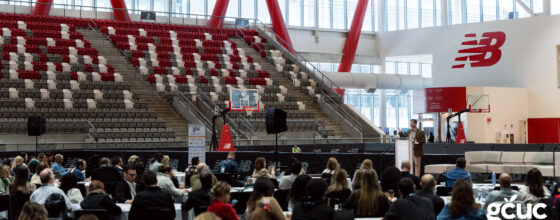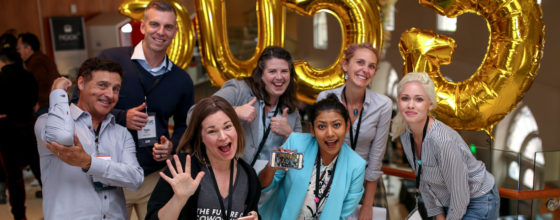Coworking Megatrend Predictions for 2020

by Liz Elam, founder of GCUC, the Global Coworking Unconference Conference
As founder of GCUC, the world’s largest coworking conference series, I travel the world learning about coworking. At the end of each year, I look ahead to where the coworking world is going and share my predictions for the coming year.
Looking Back On Our 2019 Predictions
As we stated in our Coworking Megatrend Predictions for 2019, the sleeping giant is definitely awake. The real estate industry has finally figured out that coworking is not a fad or a little blip. Coworking is significantly impacting the industry and real estate insiders are not going to sit back and wait for it to go away. Our 2019 megatrends also predicted the continued rise of real estate brands as well as the proliferation of joint venture deals and management agreements.
We covered the rise of niche spaces—particularly the rise of women-only focused spaces. We also predicted the rise of high-end luxury brands (see this recent Soho Investment) with brands finding new and inventive ways to set themselves apart. Hospitality will continue to be a big buzzword in our industry.
We talked about consolidation and the continued growth due to a strong economy and investments. Shifting gears, we talked about design evolving and older brands doing uplifts. We ‘ve continued to see the proliferation of coworking in lobbies, apartment buildings, hotels, retail spaces and pretty much anywhere.
We continue to insist that health and wellness are the future of our industry. We also believe that if connection can cure addiction then community (read: coworking) can help solve the loneliness epidemic. We talked briefly about coworking nomenclature and I have since had an epiphany about it.
Last year, we discussed how more brands would market to coworking and how they would introduce products specifically geared toward shared workspace. We also predicted the term “office” going away. (This one will take some time to prove.)
Our 2020 Megatrend Predictions
We have a lot to say this year, so turn your phone off and settle in.
Let’s get WeWork out of the way.
Wow, that spiral was something to behold.
Let’s talk about how it will affect our industry: The technology investors are on the decline, post-WeWork, for obvious reasons. The good news is that the real estate investors had to do their due diligence on WeWork and they discovered a much larger and diverse industry than they knew existed. They will need a little time but real estate will continue to invest heavily in our industry. WeWork will either raise their prices or slash them. A raise will be good for the industry a slash will be bad. Only time will tell.
Professionalism of the Industry
Coworking has moved out of its infancy. Brands are evolving and pushing forward into uncharted territory. Convene, Ucommune and others have crossed oceans. Spaces are opening first locations with 20,000 square feet or more, as opposed to 10,000.
This does not exclude the smaller spaces in remote areas which absolutely are part of this movement. Suburban and rural spaces are seeing plenty of traction and it would be ridiculous to enter a small town with a fancy 20,000 square foot space. We’re maturing and growing, getting smarter faster and more nimble.
Growth
Corporations that signed long-term multi-floor leases with WeWork are probably a little wary of our industry. The good news is there are plenty of companies that are still looking at coworking as a way to solve four key issues.
- Real Estate Costs: Coworking allows you to take it off the books
- Worker Disengagement: 66% of their workers are disengaged. Coworking, on the other hand, makes employees happier, healthier and more engaged.
- Mental Wellness: The most expensive healthcare issue for all corporations globally is the mental health crisis. If connection cures the disease of addiction then community can cure the disease of loneliness. 89% of coworkers reported being happier in a coworking space.
- Attracting and Retaining Talent: Gen Z not only doesn’t want to work in your dated office, they won’t. They need space that they choose.
Real Estate (also known a flexspace) will continue as a driver of growth.
Health and Wellness
If you’re not actively educating yourself and designing your spaces with health and wellness in mind, you are going to miss the boat.
We’re not just talking about physical health, we’re talking about mental and environmental health, as well. It’s the health of your building. It’s the lights, the air, biophilia, nature, nutrition and more.
As far as mental health, the loneliness epidemic is staggering and the numbers are downright scary. Educate yourself and help others. We must be looking for solutions and engaging in conversations.
We in the coworking industry are uniquely positioned to help move this ship. We have humans in our care for eight hours a day, they often spend more hours awake at work then at home. How are YOU going to make a difference?
The Distributed Workforce
For years we’ve been hearing about freelancers, gig workers and remote workers, but something has changed. The shift has happened and the numbers show it. We have a much larger portion of the population either choosing to work independently or being sent home to work. Humans need other humans and working from home long term contributes to the loneliness epidemic. The growth of this distributed workforce will drive significant growth for coworking.
Technology (or Lack Thereof)
More and more companies realize it doesn’t really matter where people are. They’re holding meeting on video calls and collaborating on Slack (even if the other person is in walking distance at the office.) The coworking world needs to be providing better options for collaboration, both in the physical space and online.
Coworking Exits
As leases expire and people get burnt out or are simply ready for a change, we’re seeing quite a few spaces choose to shut down or being forced to close as their rent is raised. We continue to see consolidation and expansion in coworking. We’ve even seen an evolving marketplace for evaluating and selling brands.
Recession
Yes, there will be a recession, and no, we don’t know when. Coworking was pretty much born during the Great Recession. We don’t have history on what will happen with this now-mature market but we believe brands that have built their spaces with flexibility in mind and socked away some savings will be in a good position. Will it hurt? Yes. Will coworking thrive after a dip? Yes it will. A dip may even further ignite the industry.
Inclusion and Diversity
Not a sexy topic, but it’s one that needs to be talked about. Inequality touches everyone. It’s a problem in our society and thus it’s a problem in our businesses. How do you effectively address and create inclusion for large, scaling brands as well as small businesses and entrepreneurs? We certainly don’t have all the answers, but we do have a speaker coming to GCUC in Seattle to help us demystify this trend.
Community 2.0
Full disclosure: I stole this term from Steve King of Emergent Research. Community can’t be bought, it has to be built. Community also can’t be measured, seen or touched. Yet it is the secret sauce of coworking and possibly the cure for the loneliness epidemic.
It’s time to level up. We need to figure out how to measure community and scale it in a teachable way. Other industries are discovering community—just look at how Peloton, is building a community for their brand—and pop-up shops are often a brand looking to connect and engage their community. Since coworking is a place of work and a community we need to better be able to grow it and excel at it or others will take our place.
In Summary
The WeWork effect could scare existing brands away from growth. The WeWork effect could also stall the adoption rate at which corporations adopt coworking. The WeWork effect could hold back investment in our industry. The WeWork effect could hurt or help pricing strategies in the industry. These are all fears.
If you’re in our industry, you already know that coworking attracts a certain kind of human that has a good heart, believes in people and in making the world a better place.
Don’t listen to the fears. Grow, evolve, raise money, buy buildings, educate yourself and learn. I stand by what I’ve been saying for years: You can’t build them fast enough for the demand coming our way.
Go get ‘em tiger, we’ve got a loneliness epidemic to slay…..
Liz Elam is the founder and producer of GCUC, the largest coworking conference series in the world. This year she sold her successful coworking brand, Link Coworking. She is a partner in the deco group a coworking consultancy. She is also a partner in Co.RE the first coworking real estate opportunity fund. She travels the world in a never-ending quest to promote the industry she loves and better understand the drivers and visionaries making it happen. You can catch her at an upcoming GCUC.








